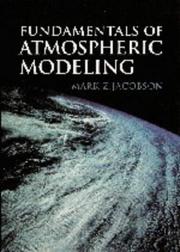| Listing 1 - 6 of 6 |
Sort by
|

ISBN: 2012353541 Year: 1999 Publisher: Paris : Hachette littératures,
Abstract | Keywords | Export | Availability | Bookmark
 Loading...
Loading...Choose an application
- Reference Manager
- EndNote
- RefWorks (Direct export to RefWorks)
Climate. --- Ecosystem. --- Earth --- Environmental modeling --- Politics

ISBN: 0521651999 0521656036 Year: 2000 Publisher: Cambridge ; New York, NY : Cambridge University Press,
Abstract | Keywords | Export | Availability | Bookmark
 Loading...
Loading...Choose an application
- Reference Manager
- EndNote
- RefWorks (Direct export to RefWorks)
Carbon cycle (Biogeochemistry) --- Marine ecology. --- Environmental modeling --- Seawater

ISBN: 2825705322 9782825705322 Year: 1996 Publisher: Genève: Georg,
Abstract | Keywords | Export | Availability | Bookmark
 Loading...
Loading...Choose an application
- Reference Manager
- EndNote
- RefWorks (Direct export to RefWorks)
Effet de serre (Meteorologie) --- Climat --- Changements. --- Changements --- Greenhouse effect, Atmospheric. --- Climat - Changements --- Environmental modeling

ISBN: 0521631432 0521637171 9780521631433 9780521637176 Year: 1999 Publisher: Cambridge: Cambridge university press,
Abstract | Keywords | Export | Availability | Bookmark
 Loading...
Loading...Choose an application
- Reference Manager
- EndNote
- RefWorks (Direct export to RefWorks)
Atmospheric physics --- Air --- Mathematical models. --- Pollution --- Modèles mathématiques --- Basic Sciences. Mathematics --- Mathematical Models, Simulation Models --- Mathematical Models, Simulation Models. --- Modèles mathématiques --- Atmospheric physics - Mathematical models. --- Air - Pollution - Mathematical models. --- ATMOSPHERE (EARTH) --- THERMODYNAMICS --- RADIATIVE ENERGY TRANSFER --- ATMOSPHERIC AEROSOLS --- COAGULATION --- WATER --- EQUILIBRIUM --- ENVIRONMENTAL MODELING --- PROPERTIES
Book
ISBN: 3039282115 3039282107 Year: 2020 Publisher: MDPI - Multidisciplinary Digital Publishing Institute
Abstract | Keywords | Export | Availability | Bookmark
 Loading...
Loading...Choose an application
- Reference Manager
- EndNote
- RefWorks (Direct export to RefWorks)
heavily Environmental mathematical models represent one of the key aids for scientists to forecast, create, and evaluate complex scenarios. These models rely on the data collected by direct field observations. However, assembly of a functional and comprehensive dataset for any environmental variable is difficult, mainly because of i) the high cost of the monitoring campaigns and ii) the low reliability of measurements (e.g., due to occurrences of equipment malfunctions and/or issues related to equipment location). The lack of a sufficient amount of Earth science data may induce an inadequate representation of the response’s complexity in any environmental system to any type of input/change, both natural and human-induced. In such a case, before undertaking expensive studies to gather and analyze additional data, it is reasonable to first understand what enhancement in estimates of system performance would result if all the available data could be well exploited. Missing data imputation is an important task in cases where it is crucial to use all available data and not discard records with missing values. Different approaches are available to deal with missing data. Traditional statistical data completion methods are used in different domains to deal with single and multiple imputation problems. More recently, machine learning techniques, such as clustering and classification, have been proposed to complete missing data. This book showcases the body of knowledge that is aimed at improving the capacity to exploit the available data to better represent, understand, predict, and manage the behavior of environmental systems at all practical scales.
geophysical monitoring --- data scarcity --- missing data --- climate extreme indices (CEIs) --- rule extraction --- Dataset Licensedatabase --- data assimilation --- data imputation --- support vector machines --- environmental observations --- multi-class classification --- earth-science data --- remote sensing --- magnetotelluric monitoring --- soil texture calculator --- machine learning --- ClimPACT --- invasive species --- species distribution modeling --- 3D-Var --- ensemble learning --- data quality --- water quality --- microhabitat --- k-Nearest Neighbors --- Expert Team on Climate Change Detection and Indices (ETCCDI) --- decision trees --- processing --- attribute reduction --- Expert Team on Sector-specific Climate Indices (ET-SCI) --- core attribute --- rough set theory --- GLDAS --- arthropod vector --- environmental modeling --- statistical methods
Book
ISBN: 3039218751 3039218743 Year: 2019 Publisher: MDPI - Multidisciplinary Digital Publishing Institute
Abstract | Keywords | Export | Availability | Bookmark
 Loading...
Loading...Choose an application
- Reference Manager
- EndNote
- RefWorks (Direct export to RefWorks)
This book presents interesting samples of theoretical and practical advances of symmetry in multidisciplinary engineering applications. It covers several applications, such as accessibility and traffic congestion management, path planning for mobile robots, analysis of shipment service networks, fault diagnosis methods in electrical circuits and electrical machines, geometrical issues in architecture, geometric modeling and virtual reconstruction, design of noise detectors, filters, and segmentation methods for image processing, and cyclic symmetric structures in turbomachinery applications, to name but a few. The contributions included in this book depict the state of the art in this field and lay the foundation for the possibilities that the study of symmetry has in multidisciplinary applications in the field of engineering.
edge preserving --- fault diagnosis --- accessibility --- urban traffic planning --- sensitivity analysis --- graphic modelling --- Coalbrookdale (Shropshire) --- mobile robot --- asymmetry --- convexity/concavity --- flying buttresses --- vibration --- time-space network --- linearization technique --- friction damping --- adaptive threshold --- ring damper --- broad learning model --- Hilbert transform --- express shipment --- symmetry --- traffic control --- railcar flow distribution --- optimization --- industrial archaeology --- high order urban hospitals (HOUHs) --- thin-walled gear --- rampant arch --- traffic congestion --- railway transportation --- robots --- virtual reconstruction --- feature selection --- geometric modeling --- path search --- industrial heritage --- weighted mean filter --- topology --- A* algorithm --- traffic forecasting --- feature interaction --- classification --- peaks distribution --- rolling bearings --- noise detector --- 3D slicer --- inclined plane --- computing applications --- environmental modeling --- extension --- service network design --- evaluation model --- anomaly detection --- random forest --- local preserving projection --- complex networks --- computer engineering --- electronic devices --- BP neural network --- mechanical structures --- segmentation --- lifting wavelet --- semi-supervised random forest --- railway network --- cathedral --- local monotonicity --- aged --- optimum --- path planning --- local data features --- local inflection --- conditional mutual information --- energy dissipation --- support vector machine --- variational mode decomposition --- Agustín de Betancourt --- optimization criteria --- tumor --- trip impedance based on public transportation --- Fisher linear discriminant analysis --- synchronization --- clustering --- geometry --- electrical circuits --- random value impulse noise
| Listing 1 - 6 of 6 |
Sort by
|

 Search
Search Feedback
Feedback About UniCat
About UniCat  Help
Help News
News